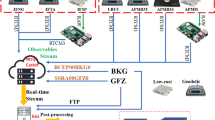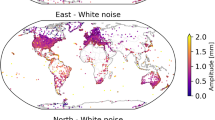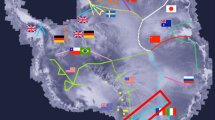Abstract
An extensive validation of tropospheric slant wet delays (SWDs) from GPS/BDS and ray tracing through numerical weather models of ECMWF was presented. The observation data of seven MGEX stations from the 120th to 130th days in 2018 were processed using the GAMIT 10.7 software. Four strategies were used to compare GPS/BDS SWD estimates and to assess the impact of several aspects of the processing strategy on the SWDs retrieval. The ray-traced SWDs based on ECMWF obtained from the RADIATE Project by the TU WIEN were taken as the references. Inter-techniques evaluations demonstrated a good agreement of GPS/BDS SWDs compared with the ray-traced SWDs based on ECMWF. The mean absolute biases (MAbias) between the GPS SWDs and the ECMWF ray-traced SWDs are about 3.7 and 4.4 cm using GPS final precise orbit & clock products and ultra-rapid orbit products, respectively. The MAbias between the BDS SWDs and the ECMWF ray-traced SWDs are about 3.9 and 4.8 cm using BDS final precise orbit & clock products and ultra-rapid orbit products, respectively. The RMSE of the GPS SWDs were about 6.6 and 7.6 cm based on GPS final precise orbit and clock products and ultra-rapid orbit products, respectively, with the ECMWF ray-traced SWDs as the reference values. And the RMSE of the BDS SWDs are about 6.0 and 7.3 cm based on BDS final precise orbit and clock products and ultra-rapid orbit products, respectively. The deviation between the GPS/BDS SWDs and the ECMWF ray-traced SWDs shows a strong elevation angle dependency especially when the elevation angle is less than 20°. The deviation is about 1 cm close to the zenith and about 6–10 cm at an elevation angle of 10°. And the deviation can reach 20–50 cm when the elevation angle is less than 3°. The above experiments show that the SWD parameters retrieved by the GPS/BDS especially using the ultra-rapid orbit products are very promising for weather forecasting and have great potential for meteorological applications.









Similar content being viewed by others
Data availability
The GPS/BDS data used in this paper can be freely accessed at https://www.igs.org/mgex/data-products. The precise ephemeris and clock products used in this paper can be freely accessed at http://www.igs.gnsswhu.cn/index.php/Home/DataProduct/ mgex.html. The ECMWF ray-traced SWD data can be obtained at http://vmf.geo.tuwien.ac.at/raytracing.html. The datasets generated during the current study are available from the corresponding author.
References
Bevis M, Businger S, Herring T, Rocken C, Anthes R, Ware R (1992) GPS meteorology: remote sensing of atmospheric water vapor using the global positioning system. J Geophys Res: Atmos 97:15787–15801
Bianchi C, Oscar Mendoza L, Fernandez L, Natali M, Meza A, Moirano J (2016) Multi-year GNSS monitoring of atmospheric IWV over central and South America for climate studies. Ann Geophys 34(7):623–639
Boehm J, Schuh H (2004) Vienna mapping functions in VLBI analyses. Geophys Res Lett 31:L01603
Böhm J, Niell A, Tregoning P, Schuh H (2006) The global mapping function (GMF): a new empirical mapping function based on numerical weather model data. Geophys Res Lett 33:1–4
Böhm J, Heinkelmann R, Schuh H (2007) Short note: a global model of pressure and temperature for geodetic applications. J Geodesy 81:679–683
Böhm J, Möller G, Schindelegger M, Pain G, Weber R (2015) Development of an improved empirical model for slant delays in the troposphere (GPT2w). GPS Solut 19:433–441
Chen B, Liu Z (2014) Voxel-optimized regional water vapor tomography and comparison with radiosonde and numerical weather model. J Geodesy 88:691–703
Chen B, Dai W, Xia P, Ao M, Tan J (2020) Reconstruction of wet refractivity field using an improved parameterized tropospheric tomographic technique. Remote Sens 12(18):3034
Ding M (2020) Reducing ZHD–ZWD mutual absorption errors for blind ZTD model users. Acta Geod Geoph 55:51–62
Elgered G, Davis J, Herring T et al (1991) Geodesy by radio interferometry: water vapor radiometry for estimation of the wet delay. J Geophys Res 96(B4):6541–6555
Flores A, Ruffini G, Rius A (2000) 4D tropospheric tomography using GPS slant wet delays. Ann Geophysicae 18:223–234
Guerova G, Jones J, Douša J, Dick G et al (2016) Review of the state of the art and future prospects of the ground-based GNSS meteorology in Europe. Atmos Meas Tech 9:5385–5406
Guo Q, Wu X (2019) A global assessment of ray-traced and blind tropospheric models in the retrieval of tropospheric parameters from ground-based GPS observations. J Atmos Solar Terr Phys 190:16–35
Hobiger T (2016) Determination of path delays in the atmosphere for geodetic VLBI by means of ray-tracing. PhD thesis. Vienna University of Technology, Vienna
Hofmeister A (2016) Determination of path delays in the atmosphere for geodetic VLBI by means of ray-tracing. Ph.D. thesis. Department of Geodesy and Geophysics, Technische Universität Wien, Vienna
Hofmeister A, Böhm J (2014) Ray traced delays in the atmosphere for geodetic VLBI. IVS 2014 General Meeting Proceedings: 283–287
Isioye O, Combrinck L, Botai J et al (2015) The potential for observing African weather with GNSS remote sensing. Adv Meteorol. https://doi.org/10.1155/2015/723071
Kačmařík M, Douša J, Dick G et al (2017) Inter-technique validation of tropospheric slant total delays. Atmos Meas Tech 10:2183–2208
Lagler K, Schindelegger M, Böhm J et al (2013) GPT2: empirical slant delay model for radio space geodetic techniques. Geophys Res Lett 40:1069–1073
Landskron D, Böhm J (2018) VMF3/GPT3: refined discrete and empirical troposphere mapping functions. J Geodesy 92:349–360
Leandro R, Langley R, Santos M (2008) UNB3m_pack: a neutral atmosphere delay package for radiometric space techniques. GPS Solut 12:65–70
Li X, Zus F, Lu C, Ning T, Dick G, Ge M, Wickert J, Schuh H (2015a) Retrieving high-resolution tropospheric gradients from multiconstellation GNSS observations. Geophys Res Lett 42:4173–4181
Li X, Zus F, Lu C, Ning T, Dick G, Ge M, Wickert J, Schuh H (2015b) Retrieving of atmospheric parameters from multi-GNSS in real-time: validation with water vapor radiometer and numerical weather model. J Geophys Res: Atmos. https://doi.org/10.1002/2015JD023454
Liou Y, Huang C, Teng Y (2000) Precipitable water observed by ground-based GPS receivers and microwave radiometry. Earth Planets Space 52:445–450
Marini J (1972) Correction of satellite tracking data for an arbitrary troposphere profile. Radio Sci 7(2):223–231
Mendes V, Langley R (1998) Tropospheric zenith delay prediction accuracy for airborne GPS high-precision positioning. In: proceedings of the Institute of Navigation 54th annual meeting, Denver, pp 337–347
Michal K, Jan D, Jan Z (2012) Comparison of GPS slant wet delays acquired by different techniques. Acta Geodyn Et Geomater 9(4):427–433
Niell A (1996) Global mapping functions for the atmosphere delay at radio wavelengths. J Geophys Res 101(2):3227–3246
Nilsson T, Böhm J, Wijaya DD, Tresch A, Schuh H (2013) Path delays in the neutral atmosphere. Atmos Eff Space Geod. https://doi.org/10.1007/978-3-642-36932-2_3
Notarpietro R, Cucca M, Gabella M, Venuti G et al (2011) Tomographic reconstruction of wet and total refractivity fields from GNSS receiver networks. Adv Space Res 47:898–912
Perler D (2011) Water vapor tomography using global navigation satellite systems. Doctoral dissertation of Eidgenössische Technische Hochschule Zürich
Saastamoinen J (1972) Atmospheric correction for the troposphere and stratosphere in radio ranging satellites. Use Artif Satell Geod 15:247–251
Schingelegger M, Möller G, Böhm J et al (2014) Troposphere delay models in blind mode-towards improved predictions of the wet component. Geophys Res Abstr 16:EGU2014-9540
Yang L, Hill C, Moore T (2013) Numerical weather modeling-based slant tropospheric delay estimation and its enhancement by GNSS data. Geo-Spatial Inf Sci 16(3):186–200
Yang F, Guo J, Shi J, Zhou L, Xu Y, Chen M (2018) A method to improve the distribution of observations in GNSS water vapor tomography. Sensors 18:2526–2540
Yao Y, Zhao Q (2017) A novel, optimized approach of voxel division for water vapor tomography. Meteorol Atmos Phys 129:57–70
Acknowledgements
The authors would like to thank the IGS data center of Wuhan university (http://www.igs.gnsswhu.cn/index.php/Home/DataProduct/mgex.html) for providing the multi-GNSS observation data and the precise GPS and BDS data products. The authors also like to thank the TU Wien for providing VMF1 tropospheric grid products and the Individual ray-tracing tool (http://vmf.geo.tuwien.ac.at//raytracing.html). This work is supported by the Shandong Provincial Natural Science Foundation, China (ZR2017MD029), the Shandong Provincial Department of Housing and Urban Rural Construction Technology Project Plan (2017-R1-004). The authors greatly appreciate the Editors and the anonymous Reviewers on this manuscript.
Author information
Authors and Affiliations
Corresponding author
Additional information
Responsible editor Silvia Trini Castelli.
Publisher's Note
Springer Nature remains neutral with regard to jurisdictional claims in published maps and institutional affiliations.
Rights and permissions
About this article
Cite this article
Guo, Q., Wu, X., Sun, Y. et al. Comparison and analysis of SWDs retrieval from GPS/BDS and validation with ray-traced delays. Meteorol Atmos Phys 133, 1661–1674 (2021). https://doi.org/10.1007/s00703-021-00833-x
Received:
Accepted:
Published:
Issue Date:
DOI: https://doi.org/10.1007/s00703-021-00833-x




